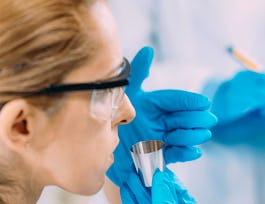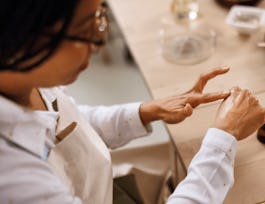Humans are amazing sensors! This course will help you understand our sensing capabilities including taste, olfaction, tactile senses, vision, and audition. The course will explain at a high-level the anatomy, physiology, and chemistry of the senses and give you an appreciation of how senses are transmitted to, and experienced by, the brain. You’ll learn by experience to assess cases such as dysfunctions in olfaction or tactile temperature adaptation. Optional podcast conversations with experts in the field are included each week to provide additional insight on our senses and sensory research.



Sensory Science: The Senses
This course is part of Essentials of Sensory Science Specialization

Instructor: Rebecca Bleibaum
Sponsored by Louisiana Workforce Commission
Details to know

Add to your LinkedIn profile
4 assignments
See how employees at top companies are mastering in-demand skills

Build your subject-matter expertise
- Learn new concepts from industry experts
- Gain a foundational understanding of a subject or tool
- Develop job-relevant skills with hands-on projects
- Earn a shareable career certificate


Earn a career certificate
Add this credential to your LinkedIn profile, resume, or CV
Share it on social media and in your performance review

There are 4 modules in this course
In this module, we will begin our discussion on the senses starting with taste. We will also discuss primary tastes, anatomy, physiology, and chemistry of taste. We will then touch on transducer and neural effects including receptor types, stimulus-receptor transducer mechanisms, neural channels, neural codes, and cortical cell types and mechanisms. We will do an activity on taste adaptation and finish the module with an optional podcast conversation with Joel Sidel. Let's get started.
What's included
11 videos7 readings1 assignment4 discussion prompts
In this module, we will continue discussing the senses focusing on olfaction and the tactile sensations. We will discuss the chemical nature of odorous stimuli, the anatomy of the olfactory system, and smell transduction. Let's begin.
What's included
6 videos2 readings1 assignment
In this module, we will discuss retronasal olfaction versus orthonasal olfaction, dysfunctions in olfaction, and the basic system to describe the tactile senses. We will also do an activity on temperature adaptation. This module will end with an optional podcast conversation with Dr. Ann Noble. Let's begin.
What's included
4 videos4 readings1 assignment2 discussion prompts
In this final module, we will continue discussing the senses focusing on vision and audition. At the end of the lesson, you will be able to describe the parts of the eye and parts of the retina. We will explain how receptor functions work, describe how to explain optical illusions, and go through aspects of depth perception. Finally, we will go into concepts surrounding hearing anatomy, transduction and adaptation. We will finish off this module with an optional podcast conversation with Dr. Armand Cardello.
What's included
10 videos3 readings1 assignment3 discussion prompts
Instructor

Offered by
Why people choose Coursera for their career




Recommended if you're interested in Health

University of California, Davis

University of California, Davis

University of California, Davis

University of California, Davis

Open new doors with Coursera Plus
Unlimited access to 10,000+ world-class courses, hands-on projects, and job-ready certificate programs - all included in your subscription
Advance your career with an online degree
Earn a degree from world-class universities - 100% online
Join over 3,400 global companies that choose Coursera for Business
Upskill your employees to excel in the digital economy


